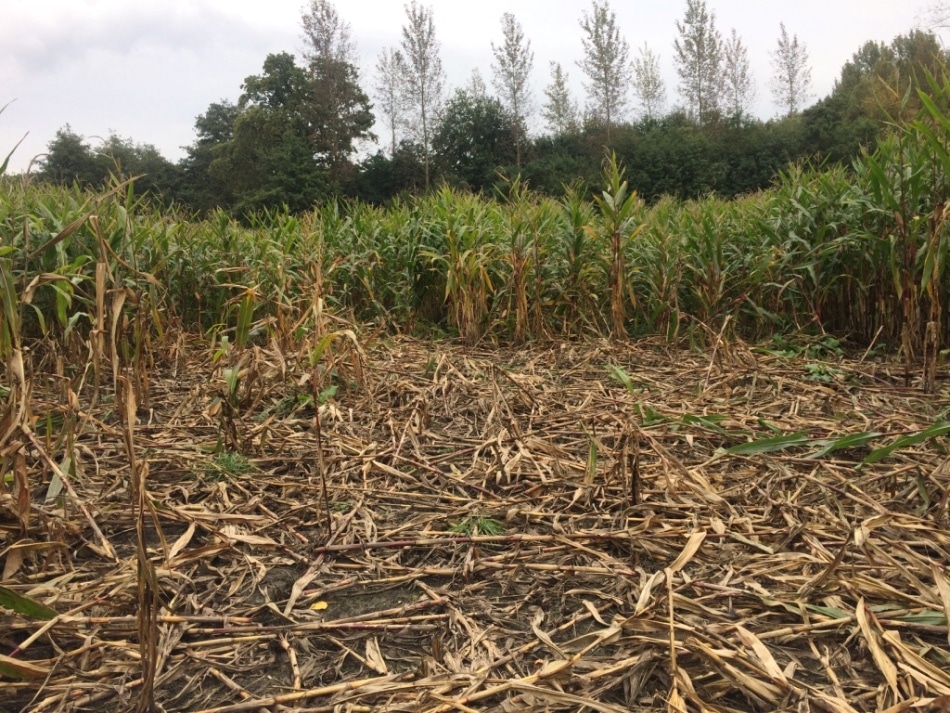Dec 12 2017
An increasing number of agricultural lands in Europe are being damaged by the rising numbers of wild boar (Sus scrofa L.), needing hundreds of thousands of Euros to offset this problem. Now, an innovative drone-based method makes it possible to estimate crop damage in a rapid, objective, and standardized way.
 Maize - Copyright Anneleen Rutten, University of Antwerp and INBO
Maize - Copyright Anneleen Rutten, University of Antwerp and INBO
This drone-based method will be presented at the ‘Ecology Across Borders’ conference in Ghent, Belgium by Anneleen Rutten, PhD student from the University of Antwerp and the Research Institute for Nature and Forest (INBO, Brussels). Rutten employs a standard commercial drone to capture aerial photographs of agricultural fields, which are examined with an algorithm to detect the damaged areas.
In many European countries, the growing populations of wild boar have been associated with disease transmissions, higher crop damage, and car accidents. In Flanders, these animals have been absent for nearly 50 years and they only returned in 2006. In fact, estimates from hunting bags reveal a rising number of wild boars which continue to expand their range, right from the eastern province of Limburg towards the more central provinces of Vlaams-Brabant and Antwerp.
During the absence of wild boar, the landscape structures in Flanders changed drastically leading to a dense, mosaic-like pattern of natural, agricultural, and urban areas. Since then, many human-wildlife conflicts have been observed. The drone-based method was developed to be easy and affordable to apply.
I want to get a first insight into the extent of agricultural damage by wild boar because, in contrast to neighbouring regions and countries, this has not been monitored in the past and it is not known how high the financial damages are for this sector. I connect my smartphone to the remote controller of my drone which allows me to see the camera visualisation. Damage is really clear on the camera: in maize fields, boars roll over the maize which results in gaping holes with broken stems in an otherwise green field. In grasslands, rooting causes a clear colour difference because the soil is rooted up.
Anneleen Rutten, PhD student from the University of Antwerp and the Research Institute for Nature and Forest (INBO, Brussels)
Many separate photographs with 75-85% overlap are taken for each field. The high overlap makes it possible to combine individual photographs into one image, taking account of various perspectives and highlighting the entire field. Then, using Object Based Image Analysis (OBIA), the field area is grouped into undamaged and damaged parts. The algorithm achieves an accuracy of 93% for maize fields and an accuracy of 94% for grasslands.
Generally, trained experts estimate crop damage by measuring the damaged part in the field. “Flying and taking photographs of damaged fields does not take as long as doing an assessment by ground visits, making it more cost-effective”, Rutten adds. Another benefit is that the method is standardized, enabling direct comparisons between various fields and over time.
Anneleen Rutten will describe her work at the ‘Ecology Across Borders’ conference held on Tuesday 12, December 2017.
This year’s annual meeting is mutually organized by the British Ecological Society, Gesellschaft für Ökologie (the Ecological Society of Germany, Switzerland and Austria), and Dutch-Flemish Ecological Society (NecoV), in collaboration with the European Ecological Federation, bringing together 1,500 ecologists from around 60 countries to talk about the latest developments in ecological research across the entire discipline.